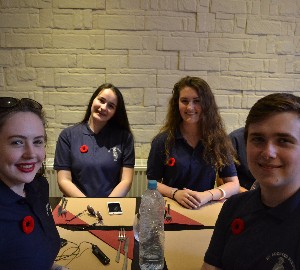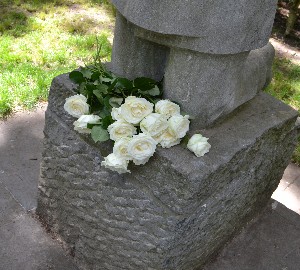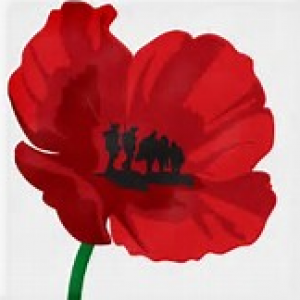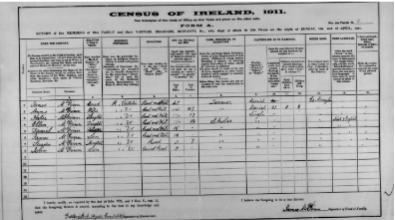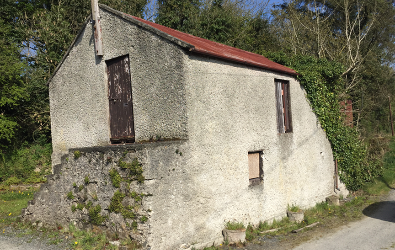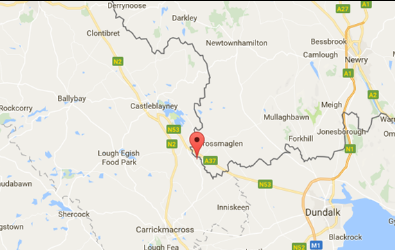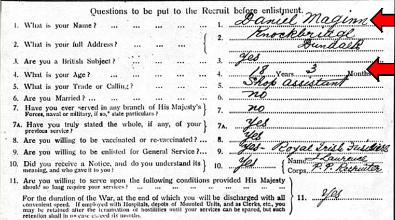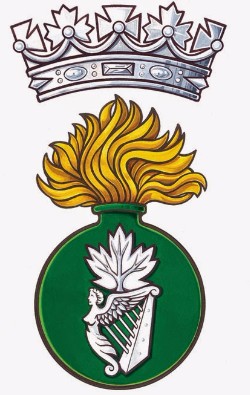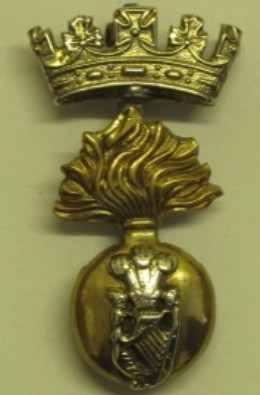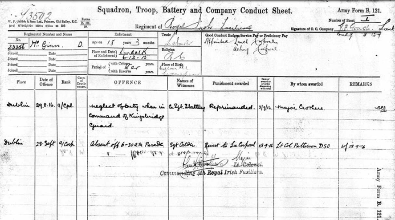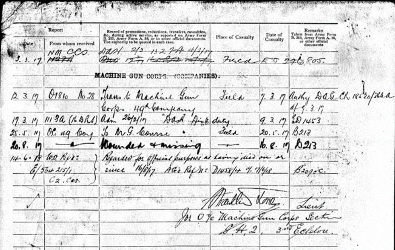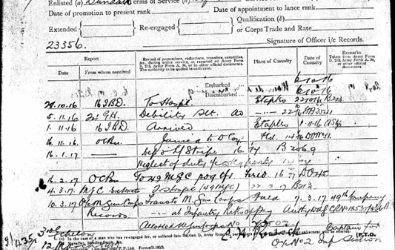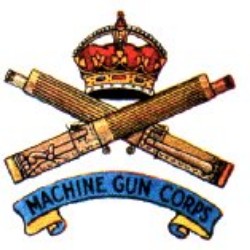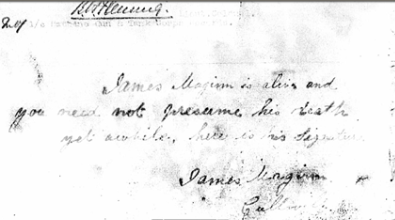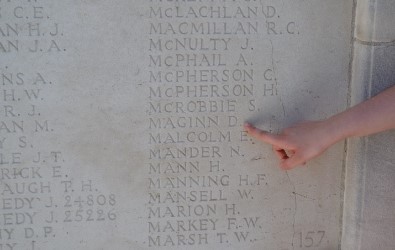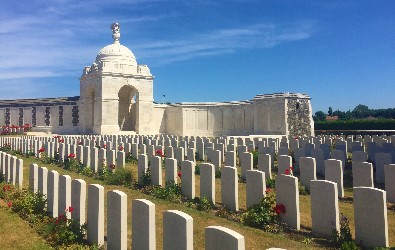So when they told me you’d been left for dead I wouldn’t believe them, feeling it must be true. Next week the bloody Roll of Honour said “Wounded and missing”—(That’s the thing to do when lads are left in shell-holes dying slow, With nothing but blank sky and wounds that ache, Moaning for water till they know It’s night, and then it’s not worth while to wake!)
From 'To Any Dead Officer' By Siegfried Sassoon-ra4jg3.jpg)
Cleaning the graves of German soldiers at Vladslo Cemetery.
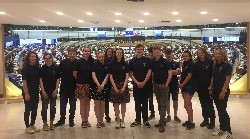
The Irish students at the European Parliament.
-wbkbny.jpg)
Myself, David Dunlop and Ciara Hamilton performing at the grave of John Condon.
Why I applied to the My Adopted Soldier Project
I have had a love for history from a very young age, however my interest in war history didn't begin until I was in Second Year. As part of my Junior Certificate English course, I studied the works of Wilfred Owen and Siegfried Sassoon. This really sparked an interest in me and I went on to read "All's Quiet on the Western Front" by Erich Maria Remarque and "How Many Miles to Babylon" by Jennifer Johnston. I jumped at the opportunity to apply to the project because I wanted to remember the Irish heroes that history has forgotten and give them the glory that they were promised.
First Meeting in Collins' Barracks
I attended the first meeting in Collins' Barracks on the 4th of February 2017. I met with the project organisers and the 14 other Irish students who are partaking in the project. We were all given names of local soldiers to research.
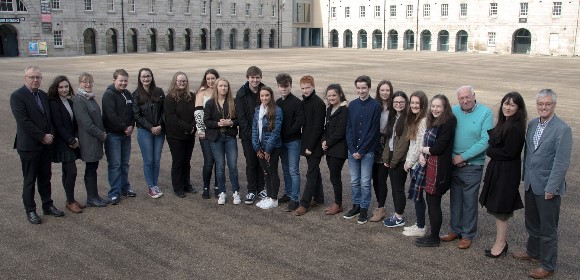
Researching my soldier
Daniel was not the original soldier that I was given. I happened to see his name on the Monaghan Role of Honour and I decided to research him as his home place is only five minutes from my house. I then discovered that Daniel died on the 16th of August 1917- which happens to be my birthday. So, the centenary of Daniel's death was my seventeenth birthday. This made me feel as if I had a personal connection with Daniel and I was eager to learn more! I reached out Gerry O'Neill, a retired member of the Irish Army as a part of my research, and he helped me to go through Daniels Service Records. I was also fortunate to meet Gerry Kelly, Daniel's nephew. He was very helpful and was able to give me a lot of information about Daniel and his family.
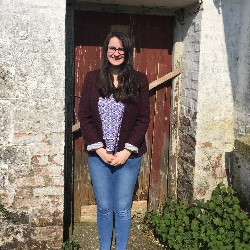
Visiting the primary school Daniel attended.
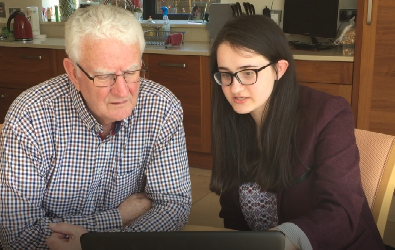
Meeting with Gerry Kelly, Daniel's nephew.
Second Meeting in Collin's Barracks
On the 13th of May 2017, the fifteen Irish representatives met again in Collin's Barracks. In attendance were Marian Harkin MEP, Niamh Crowley, President of the History Teacher's Association of Ireland, David Grant, Chief Executive of the Irish College in Leuven, Kevin McCarthy and Frances Moss, History Inspectors, and Ian Chambers from the Dublin Branch of The Western Front Association. Four students, one from each province, were asked to give a presentation on the soldiers they researched. I was honoured to be able to share the story of Daniel McGinn to my fellow students.
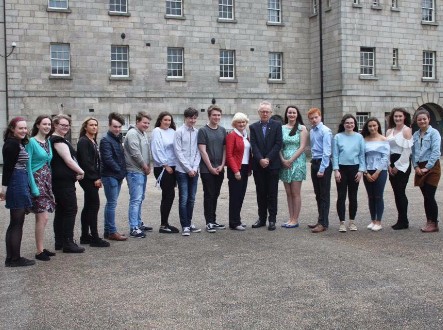
The Trip
Day 1
Our journey began in Dublin Airport on Tuesday June 20th. A plane ride and a bus journey later, we arrived at the Irish College in Leuven. By the time we arrived in Leuven it was very late, so we went straight to bed to start fresh the next morning.
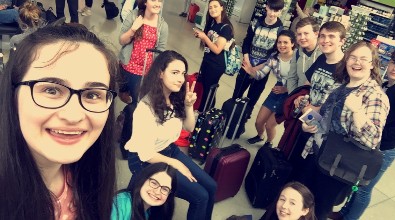
Day 2
After breakfast the next morning we received a lovely guided tour from David Grant. We had some free time in the beautiful town before walking back to the Irish College. Here, we met our German counterparts for the first time. We participated in some icebreakers, before breaking off into teams to compete in a (rather difficult) scavenger hunt around Leuven. Thankfully, Conor's suprising ability to speak Flemish aided our team's effort! After dinner we listened to some presentations from Rosie, Zoé and two German students. We finished the day by buying wind-up fans and Ben and Jerry's to combat the sweltering heat followed by myself, and the amazingly talented Ciara Hamilton and David Dunlop retreating to a quiet room to play and sing some Irish tunes!
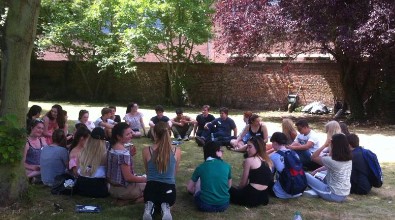
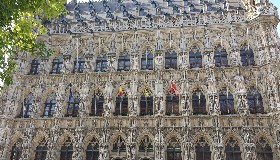
The City Hall
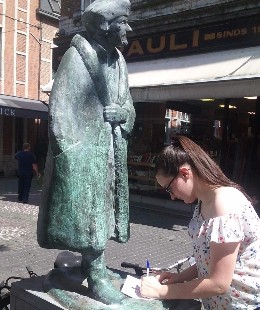
Me with Leuven's statue of Erasmus during the treasure hunt
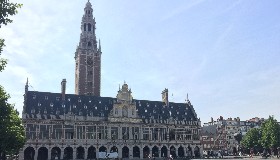
The Library of the Catholic University of Leuven
Day 3
Thursday was an extremely busy day for us! We began the day with a bus journey to the European Parliament where we met Irish MEP, Marian Harkin and German MEP, Gesine Meißner. We also listened to presentations from Sarah Mc Grath and one of the German students about the soldiers they studied.
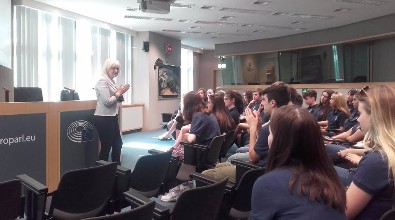
We then continued on to the Island of Ireland Peace Park. This is a memorial to the Irish soldiers who died, were wounded or are missing from the Great War. The park contains a traditional round tower and is built from Irish stone. We found it particularly poignant when Gerry Moore told us that the sun only enters the interior of the tower once a year- on the eleventh hour, of the eleventh day of the eleventh month i.e the anniversary of the armistice that ended the Great War.
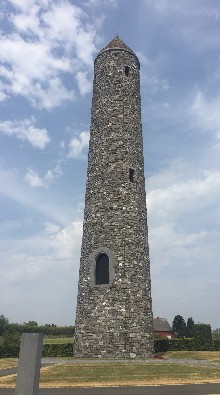
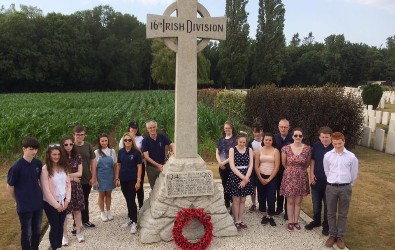
The Irish students at a memorial to the soldiers of the 16th Irish Division
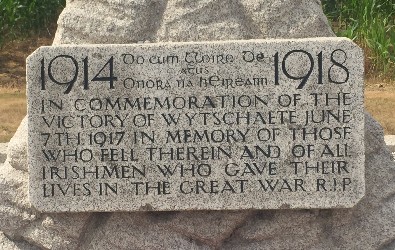
The inscription on the memorial
We continued on and visited the Messines Military Cemetery, the Pool of Peace, Wytschaete Cemetery and the Heuvellend Tourism Office. As Irish students, we found the Pool of Peace shocking as it was hard to imagine the loss of German lives caused by soldiers fighting alongside our ancestors. However, it was only when we visited the Bayernwald German Trenches that we really understood the plight of the German soldiers that fought there. On the left is a photo of Joshua and myself as we walked through the trenches. During our walk we came to the realisation that if Joshua had been born one hundred years earlier, he probably would have fought in trenches very similar to the ones we were in. This really personalised the project for us and we realised how important it is to prevent another tragedy like this happening.
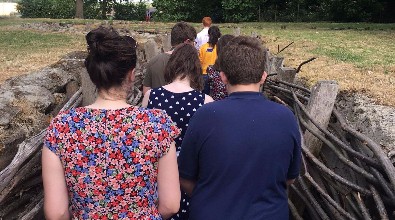
The last activity of the day was a visit to the death cells and execution place used by the British Army in Poperinge. Here we listened to Joshua tell the story of his soldier who was executed by firing squad. We also got an opportunity to look inside the cells where soldiers who were sentenced to death spent their final hours. To this day, the walls have names and messages carved into them from the men who were brutally killed by their own comrades. Needless to say, it was a pretty emotional experience for us all. We stayed locally that night in a hostel, where the Irish students played (a very sorry attempt at) a GAA match! The students really started bonding and we all started to become close friends.
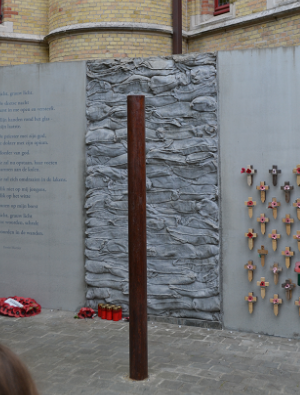
Day 4
We had another extremely busy day on Friday. We started our day with a trip to Poperinghe New Military Cemetery, followed by a trip to Vladslo (German) Cemetery. We found it a horrifying experience to see the difference between the graves of the victors and losers. Not even in death are they equal. So, a group of the Irish students, myself included, decided to try and clean as many of the German graves that we could in the short time that we had in the graveyard, to show respect to the men who were buried there.
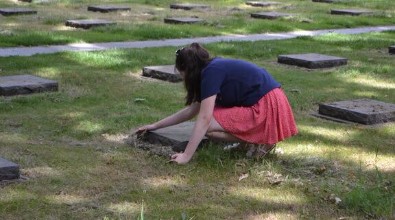
We moved on to Poelcapelle British Cemetery. This cemetery contains the grave of John Condon, who is believed to have been the youngest soldier who died in the Great War. He was a Waterford native. Kevin Mc Carthy read an oration at the graveside and Ciara played the tin whistle. Then, I sang the eponymous song accompanied by David Dunlop on guitar.
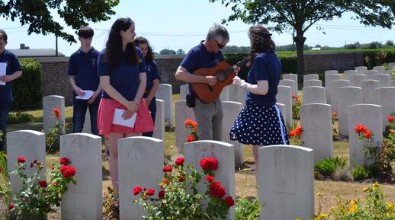
Visiting Tyne Cot
We continued on to the cemetery at Langemarck and then we moved to Tyne Cot.
Visiting the Tyne Cot Memorial was really something I hadn't prepared for. After researching Daniel and learning about his life, it was such a surreal and emotional experience to see his name carved in stone among thousands of others. I left a rock that I took from his house at the memorial to leave a piece of his home there. It was upsetting to think that the last record of Daniel is his name spelt incorrectly on a memorial.
-m9gjyh.jpg)
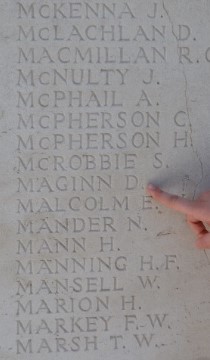
-5w5k16.jpg)
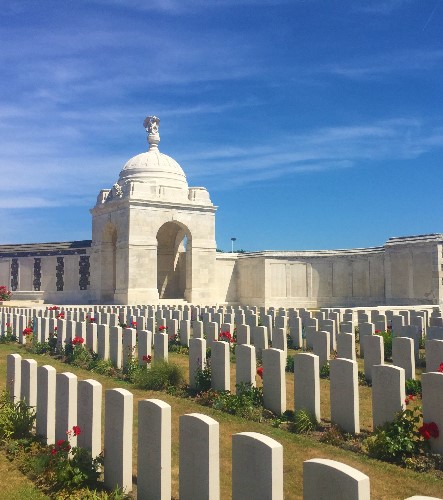
The Last Post Ceremony at Menin Gate
After having already visited Menin Gate earlier in the day to see Ciara's soldier's name, we returned to attend The Last Post Ceremony. Gerry Moore, the project director, said the oration and a wreath was laid by Ciara, on behalf of the Irish students and by Yassin, on behalf of the German students. It was an amazing experience and we were all so grateful to have had the opportunity to attend.
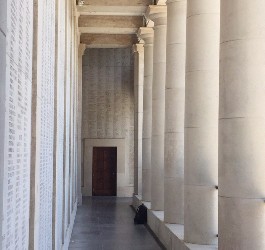
The Menin Gate Memorial
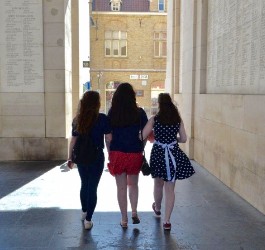
(L-R) Sarah McGrath, myself and Ciara Hamilton at the Menin Gate Memorial
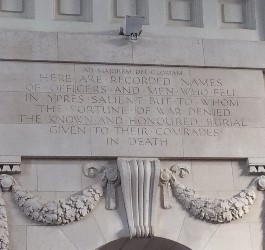
The Menin Gate Memorial
Day 5
Our final day was mostly spent travelling. We set off from Leuven at 8:30 am and shared an emotional bus journey to Amsterdam Airport Schipole, realising that we had to make the most of our final few hours together! We said our goodbyes in Dublin Airport (with many, many tears) but we have all stayed in contact and remained really good friends!
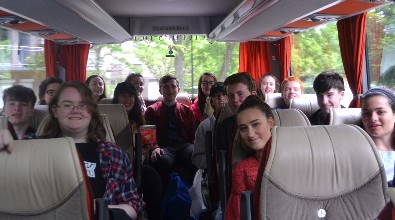
A final word
I would like to take this opportunity to thank Gerry Moore and the My Adopted Soldier committee for giving me this amazing experience. I have benefited so much from the project and I am so honoured to have been able to commemorate Daniel and his story.
On that note, I would like to thank both Gerry O'Neill and Gerry Kelly for their help with researching. They have both have been such a help and my job would have been so much more difficult without them.

